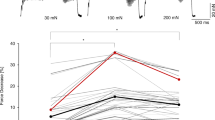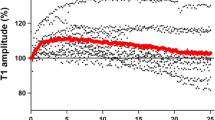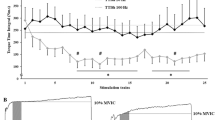Abstract
Nondepolarizing neuromuscular blocking drugs induce train-of-four (TOF) fade, i.e., the reduction of the fourth to the first twitch height in a train under TOF stimulation. It has been observed that the degree of TOF fade varies with the drug used and is inversely correlated with the potencies of the drug. In this study, the cause of difference of TOF fade was considered using a dynamic model. The model was based on the following assumptions: (1) Twitch response is evoked by the binding of acetylcholine (ACh) molecules to the postsynaptic nicotinic receptors in a neuromuscular junction, (2) time-dependent ACh mobilization in a motor nerve terminal results in less ACh output at the fourth stimulus in a train than at the first stimulus, (3) the drugs compete with ACh for the postsynaptic receptors and inhibit the receptor-binding of ACh, and (4) the drugs have various affinities for the receptors. This study suggested that the difference of affinities of the drugs for postsynaptic ACh receptors may cause the difference of TOF fade.
Similar content being viewed by others
References
Ali HH, Savarese JJ (1976) Monitoring of neuromuscular function. Anesthesiology 45:216–249
Jones RM (1985) Neuromuscular transmission and its blockade. Anaesthesia 40:964–976
Williams NE, Webb SN, Calvey TN (1980) Differential effects of myoneural blocking drugs on neuromuscular transmission. Br J Anaesth 52:1111–1115.
Gibson FM, Mirakhur RK (1989) Train-of-four fade during onset of neuromuscular block with nondepolarizing neuromuscular blocking agents. Acta Anaesthesiol Scand 33:204–206
Klein L, Hopkins J, Rosenberg H (1983) Different relationship of train-of-four to twitch and tetanus for vecuronium, pancuronium and gallamine. Anesthesiology 59:A275
Tajima T, Kaneko K, hatanaka T, Aiba T, Katayama K, Koizumi T (1994) Kinetic analysis of neuromuscular blockade. I. Relationship between twitch depression and stimulation frequency after d-tubocurarine administration. Biol Pharm Bull 17:1083–1088.
Tajima T, Kato Y, Hatanaka T, Aiba T, Katayama K, Koizumi T (1994) Kinetic analysis of neuromuscular blockade. II. Train-of-four fade induced by d-tubocurarine and α-bungarotoxin. Biol Pharm Bull 17:1089–1093
Cheah LS, Gwee MCE (1988) Train-of-four fade during neuromuscular blockade induced by tubocurarine, succinylcholine or α-bungarotoxin in the rat isolated hemidiaphragm. Clin Exp Pharmacol Physiol 15:937–943
Gwee MCE, Cheah LS (1989) In vitro time course studies on train-of-four fade induced by hexamethonium, pancuronium and decamethonium in the rat isolated hemidiaphragm. Clin Exp Pharmacol Physiol 16:897–903
Bowman WC, Marshall IG, Gibb AJ, Harborne AJ (1988) Feedback control of transmitter release at the neuromuscular junction. Trends Pharmacol Sci 9:16–20
Wessler I, Rasbach J, Scheuer B, Hillen U, Kilbinger H (1987) Effect of (+)-tubocurarine on [3H]acetylcholine release from the rat phrenic nerve at different simulation frequencies and train lengths. Naunyn Schmiedebergs Arch Pharmacol 335:496–501
Wilson DF (1979) Depression, facilitation, and mobilization of transmitter at the rat diaphragm neuromuscular junction. Am J Physiol 237:C31-C37
Namba T, Grob D (1968) Cholinesterase activity of the motor endplate in isolated muscle membrane. J Neurochem 15:1445–1454
Paton WDM, Waud DR (1967) The margin of safety of neuromuscular transmission. J Physiol (Lond) 191:59–90
Black JW, Leff P (1983) Operational models of pharmacological agonism. Proc R Soc Lond B Biol Sci 220:141–162
Miller RD, Savarese JJ (1986) Pharmacology of muscle relaxants and their antagonists. In: Miller RD (ed) Anesthesia. Churchill Livingstone, New York, p 897
Swerdlow BN, Holley FO (1987) Intravenous anaesthetic agents pharmacokinetic-pharmacodynamic relationships. Clin Pharmacokinet 12:79–110
Filatov GN, Alywin ML, White MM (1993) Selective enhancement of the interaction of curare with the nicotinic acetylcholine receptor. Mol Pharmacol 44:237–241
Sheiner LB, Stanski DR, Vozeh S, Miller RD, Ham J (1979) Simultaneous modeling of pharmacokinetics and pharmacodynamics: Application to d-tubocurarine. Clin Pharmacol Ther 25:358–371
Graham GG, Morris R, Pybus DA, Torda TA, Woodey R (1986) Relationship of train-of-four ratio to twitch depression during pancuronium-induced neuromuscular blockade. Anesthesiology 65:579–583
Parker CJR, Hunter JM (1992) A new four-parameter threshold model for the plasma atracurium concentration-response relationship. Br J Anaesth 68:548–554
Author information
Authors and Affiliations
About this article
Cite this article
Tajima, T., Amaya, J., Katayama, K. et al. Difference of train-of-four fade induced by nondepolarizing neuromuscular blocking drugs: a theoretical consideration on the underlying mechanisms. J Anesth 9, 333–337 (1995). https://doi.org/10.1007/BF02479947
Received:
Accepted:
Issue Date:
DOI: https://doi.org/10.1007/BF02479947




